
Star Trek Strange New Worlds Season 2 Finale Recap—Gorn, Scotty
“Experimental” is a word that has defined much of Star Trek: Strange New Worlds’ second season. From tackling head-on iconic Star Trek episodes with its own takes, to bold plays with format like its Lower Decks crossover or last week’s musical episode, this season has been unafraid to take swings, even when they don’t quite always land. Perhaps it’s fitting then that one of its surprisingly biggest swings comes in its finale, a small thing in hindsight that brings with it a few doubts in context.

It’s perhaps best to get this out of the way quickly, as it’s a structural choice that defines a lot of what works and what doesn’t about “Hegemony.” While there’s definitely a few surprises in the episode Paramount did a good job of keeping quiet before release (more on the big one later), the most jarring of all is that the episode is, in fact, Strange New Worlds’ first ever two-parter. And, in true Star Trek tradition, it’s using the format to bookend one season and start another.
This is, of course, an extremely valid and normal thing for a TV show to do—and for Strange New Worlds in particular, it makes sense to play with a format that Star Trek itself has used plenty of times before. Majel Roddenberry’s legendary voice telling us “And now, the conclusion…” at the start of iconic two-parters’ second halves across the likes of TNG, DS9, and Voyager is burned into Trek fan minds for a reason. But first crack at the whip on a Trek tradition aside, “Hegemony” stumbles largely because of the constraints of that format—with a set up that provides as few answers as possible to the litany of questions it asks, most particularly about just how Strange New Worlds is going to start changing its view of the Gorn.
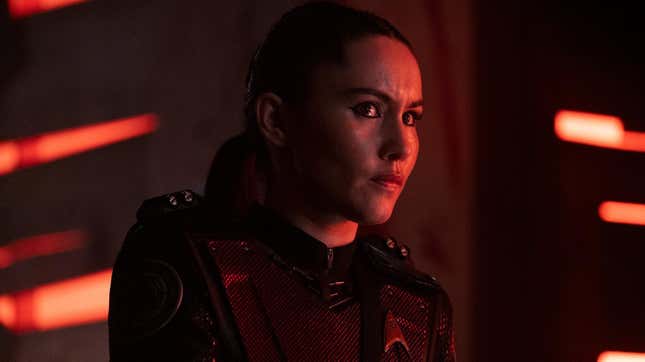
Because yes, as the name of the finale implies, the Gorn are once again in the spotlight this week, as the Enterprise finds itself thrust into a deadly situation above the independent colony Parnassus Beta. Just outside of Federation space and being aided by teams from the USS Cayuga, the ship helmed by Pike’s paramour Captain Batel (returning guest star Melanie Scrofano), the planet’s inhabitants find themselves invaded by the Gorn, who promptly isolate the world from communication and scanning with a jammer, destroy the Cayuga where it stands in orbit, and make their first major contact with Starfleet: to draw a line in the symbolic sand that they should never cross.
All of this leads into “Hegemony” largely being a mix of ideas, tones, and themes the show has played with for the most part more strongly in other episodes. The Gorn themselves have already spurred these similar points twice before in their Strange New Worlds appearances—their first in “Memento Mori” gave us the Enterprise dealing with a disaster on the scale of ship destruction, although that’s largely transposed to the Cayuga (or what’s left of it) here. Then, in turn, “All Those Who Wander” gave us the Alien-tinged horror take on the alien species that the colony-set sequences here try to emulate, albeit much less effectively this time around. The final piece of the puzzle is the episode’s moral and ethical dilemmas when it comes to Starfleet and conflict, which of course Strange New Worlds deftly handled in its last season finale, “A Quality of Mercy,” in its own take on the greatest Star Trek tale of all time, “Balance of Terror.”
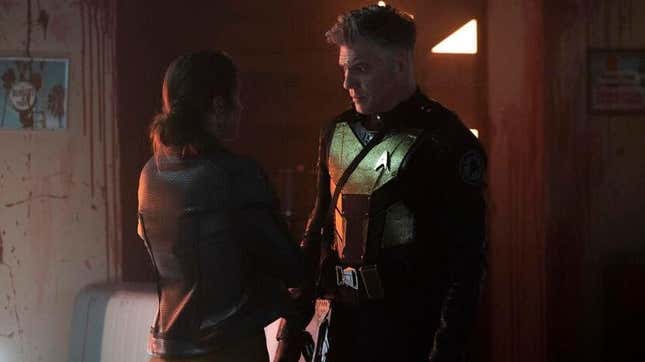
It’s not to say that Strange New Worlds cannot return to and re-explore these kinds of ideas. But the strengths of those prior episodes were that they were singular, completed stories: they could tell the tales they need to and be done with them, and reach satisfying conclusions. “Hegemony” by its very nature as the first half of an incomplete story, and because it tries to re-navigate all of these different angles and genres at once, simply can’t—there’s just too much going on and intentionally a lot of what it’s doing is left unfinished by the episode’s end. What we get then is mostly great moments—of action and drama alike—and the promise of ideas.
Thankfully, those ideas are very promising indeed for the most part. The other “surprise” of the episode beyond it being a two-parter is that also seeking solace from the Gorn on Parnassus Beta at the time of the invasion is none other than a young Lieutenant Montgomery Scott (Martin Quinn), whose research vessel had already been attacked by the invasion force before it struck the colony. While this season’s experimentations with a young Jim Kirk have ranged from a tool to explore Strange New Worlds’ original characters—especially La’an—to the small ways the series wants to start setting up the eventual future Enterprise we know in classic Star Trek, bringing aboard a young Scotty feels like a much less daunting prospect for the show to explore than it does a young Kirk. After all, Scotty was rarely Trek’s most spotlighted character, and getting to share a formative development for him aboard the Enterprise—as he seems to be set up to do so by the episode’s cliffhanger climax—gives Strange New Worlds a much bigger canvas to paint on than it has with Lieutenant Kirk. And although his presence robs some of the horror aspects of the episode—as Pike defies Starfleet to send an away team down to the surface to liberate survivors and locate Captain Batel—of their tension, in so much he is another character among the cast the show can’t really threaten, the potential the show has with this character, and in Quinn’s wonderful performance of the affable Mr. Scott (the promise of teaming him up with Carol Kane’s Pelia is delightful) is already palpable.
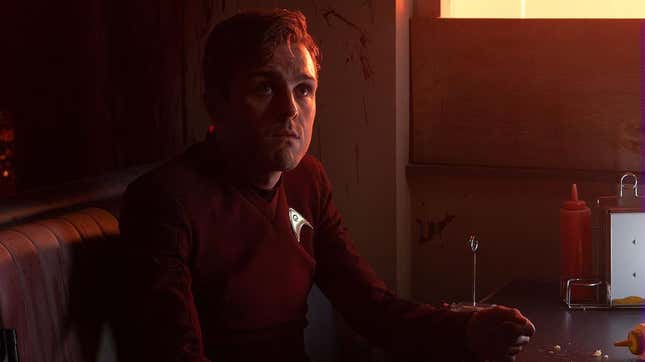
Another big, promising idea of “Hegemony” is, thankfully, the Gorn themselves. For the most part their role here is the aforementioned mix of their prior appearances: in orbit, Number One, Spock, and Uhura navigate the threat of Gorn frigates doing to them what they already did to the Cayuga, while exploring ways to shut down the Gorn dampening beacon on Parnassus Beta’s surface. Meanwhile on the ground while Pike’s away team sneaks to the surface to find survivors, we get the horror and tension of their appearance in “All Those Who Wander,” as the group slinks through burned out streets and hides from swarms of Gorn younglings. And while that’s all well and good—it remains an interesting point that the show has made the Gorn its “big bad” so far—what “Hegemony” crucially adds is an ethical and moral conflict that gives the species the inkling of layers any good Star Trek villain should have: a feeling of actual personhood.
Up to this point, from the perspective of the metatext and the text of Strange New Worlds so far, the Gorn are explicitly monstrous. Their appearance is more creature-like than humanoid, there is no reasoning with them, they exist to destroy our heroes, and our heroes have no desire or reason to do anything other than destroy them first. While Star Trek has its fair share of conflicts that can’t be solved by reason and understanding—that’s why the Borg were so horrifying, beyond being cyber-zombies—it has felt odd to see Strange New Worlds explore a golden age of Starfleet ideals and exploration where our heroes’ biggest threat has seen them attack first and… well, not even ask questions later. Even if the Federation’s relationship with the Gorn is not that great by the time of the original series, it’s better than this, and Strange New Worlds seemingly finally knows that. Although it starts in that same hostile place—when alerting Starfleet of the situation Pike flatly and without remorse says that sometimes a monster is just a monster, before promptly revealing to his senior staff that Starfleet has been outfitting vessels with crates of specifically anti-Gorn weaponry and ship countermeasures—the inkling is here to give the Gorn if not a sense of humanity, at least a recognition as a sentience species that should exist beyond our heroes’ desire to exterminate them.
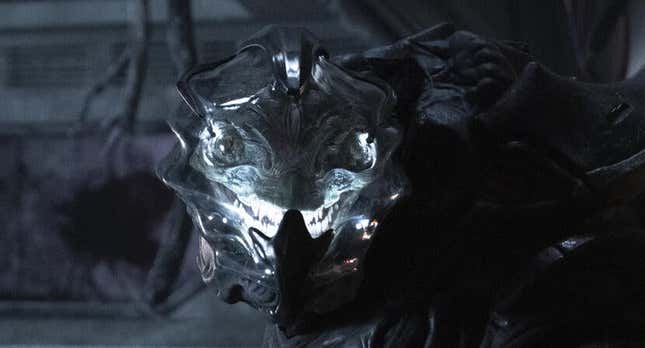
As Spock spacewalks to the remnants of the Cayuga to use it as an improvised weapon against the dampening beacon (and, it turns out, to rescue a convenient lone survivor in Nurse Chapel, who was conveniently on the Cayuga to head to her research fellowship, an awkward premise that at least lets Spock and Christine have closure on their relationship outside of song), Strange New Worlds finally gives us an adult Gorn. They’re not their youngling form rendered bigger, badder, and more feral, either: they are a being, in their own spacesuit, navigating the systems of the stricken ship as much as Chapel and Spock are. Although the encounter between the adult Gorn and our heroes still ends in violence, it’s not portrayed as heroic or a horror scene for them to overcome—Spock plunges space debris into the Gorn’s helmet and he and Chapel have to watch it writhe and struggle in its final moments. It’s scary because of what they did, not the Gorn themselves, it’s scary because we are invited to feel sympathy for a Gorn for the first time. Even as the climax builds and “Hegemony” sets up a whirlwind of crises for its cliffhanger conclusion—largely based around the threat of conflict the Gorn represent—this is a vital first step in Strange New Worlds actually treating its major foe with the kind of nuanced and layered understanding we usually expect of its heroes, and that’s important for the show to begin to address.
Begin is all it can do, however. As noted, “Hegemony” can only largely posit questions instead of answer them, because otherwise there’d be no point in a two-part story. It also has to turn itself to setting off the cascade of events that shape its cliffhanger, drawing its focus to the spectacle of it all rather than the potential of its cerebral elements. And it certainly is a cascade: Spock’s plan works, destroying the Gorn jammer with the Cayuga’s remnants, but only Batel, Scott, and Pike get off world safely—the surviving colonists and crew of the Cayuga, as well as Pike’s away team, are all immediately beamed up by the Gorn instead. Those same Gorn are then bolstered by the arrival of a whole support fleet, who begin strafing the Enterprise and threaten to tear the ship a new one all over again. And Pike himself is compromised by his personal circumstances—learning that Batel has been infected with Gorn eggs just as Hemmer tragically was last season, he now finds himself pulled between the needs of his ship, the needs of his captured crewmates and their civilian refugees, and the needs of his relationship with Batel. He can’t bring himself to decide whether to retreat, fire on the Gorn, or even do anything as the episode fades out to its cliffhanger conclusion.
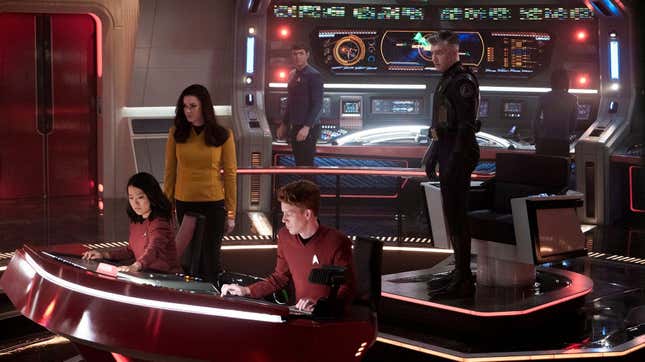
And now, the conclusion will be a very long time off. Obviously Strange New Worlds could never have predicted its second season would drop amid a Hollywood labor movement unseen in scale for over half a century, nor that that movement would render work on a third season impossible for the foreseeable future. So we’re left to wait, and wonder, if the series will be able to pull off a lot of what it’s putting down in this episode—which will likely become one of the show’s biggest experimental successes if it does.
Want more io9 news? Check out when to expect the latest Marvel, Star Wars, and Star Trek releases, what’s next for the DC Universe on film and TV, and everything you need to know about the future of Doctor Who.

